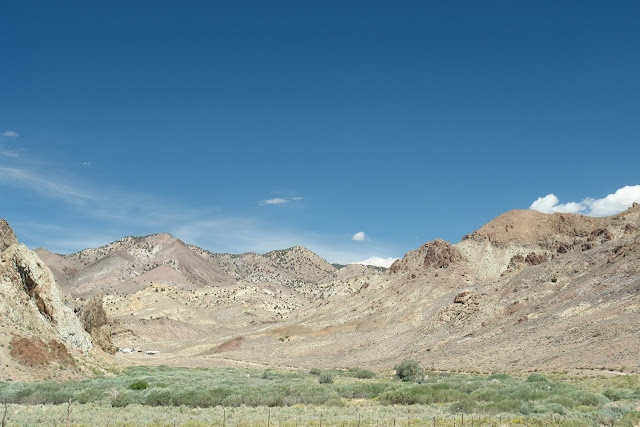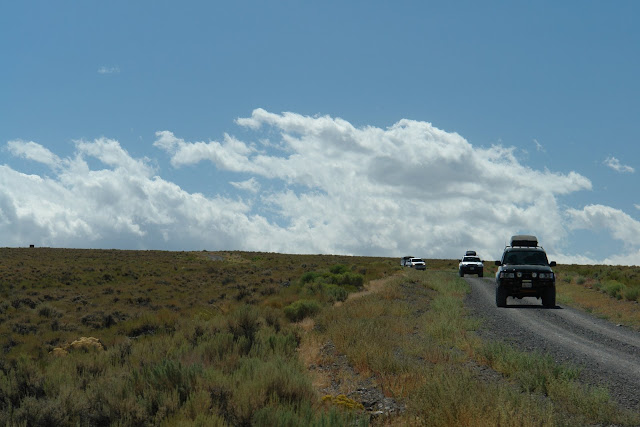Echo_29
Observer
Planning
In 2005 my wife Mary-Austin and I drove from Los Angeles to Ketchum, Idaho via Las Vegas (for gas only please) then north along the eastern edge of Nevada via Highway 93. We returned through Twin Falls, ID then south reentering Nevada through Jarbidge (reported to be the least urbanized location in the lower 48). From Jarbidge we continued on to Wells, Austin, Eureka and finishing up with three days in and around Tonopah.
Images from that trip can be found here: Part I and Part II
Impressed with the state’s natural beauty we returned this year throwing a broad net over central and northeast Nevada. The intent was to revisit some places we'd seen before while moving into some new areas to check out the topography, the landscape and historical features. From this survey we’ll plan future trips. Once we'd set aside two weeks for our wander I began plotting our path. On our prior trip we'd come through in the middle of August, this time we decided to push those dates back to early September, not to avoid the heat but the thunderstorms that wrecked havoc on us in 2005.
The initial route turned out to be a little more ambitious then I'd planned. I wanted two things that are usually mutually exclusive, to see a fair amount of country and to have a fairly relaxing trip both in a relatively short amount of time. I also wanted to share Nevada's amazing subtle landscapes with friends.
To plan the trip I consulted the following: The Complete Nevada Traveler by David Toll, Hot Springs and Hot Pools of the Southwest by Marjorie Gersh-Young, Stan Paher’s Illustrated Nevada Ghost Towns & Mining Camps- Volumes One and Two, 50 Classic Hikes in Nevada by Mike White, Geology Underfoot in Central Nevada, Nevada DeLorme Atlas and Gazetteer, Nevada Map Atlas-17th Edition by the Nevada Dept of Transportation, GoogleMap and GoogleEarth.
Day 1 – Friday – 8.29.2008
Finally, after months of anticipation, we departed Los Angeles for Tonopah, Nevada where we’d be meeting up with James and Michelle from Pasadena in their 80 Series Land Cruiser and Stacy, George and Ivy and Graham from San Mateo in their 120 Series 4Runner.
Sixty miles outside of Tonopah we turned south off U.S Route 6 and onto State Route 264 then east off pavement and into Fish Lake Valley for a soak at the Fish Lake Hot Springs.

The Fish Lakes were created in the 1880s when a rancher drilling for oil struck hot water instead. The 103 degree water flows at a rate of 50 gallons per minute from a well casing into a concrete soaking tub which then overflows into two large yet shallow lakes. Departing the springs we had a magnificent dusk lit drive north through the multi-hued volcanic landscape of Fish Lake Valley.

Day 2 – Saturday – 8.30
Departing from Tonopah we headed out of town to investigate the WWII era munitions bunkers and hangers at the Tonopah Airport.

Built as an Army Air Field training base, and now municipally owned, it houses an odd assortment of elements: a local raceway, a refinery works reminiscent of something out of Mad Max, groves of transplanted Joshua Trees, and three large wooden and concrete aircraft hangers abandoned to time, the elements and at least one large Great Horned Owl.


Leaving the airport we drove north up Ralston Valley on State Route 376 until we entered the Big Smokey Valley then turned off pavement and entering the Humboldt-Toiyabe National Forest.
After entering the National Forest we climbed Peavine Canyon to its end at Tom’s Canyon south of the jutting Arc Dome (elevation 11,361’) then returned back down the canyon to the shaded Peavine Campground for lunch.

Running later than expected and needing to meet the last party of our group, we skipped our planned climb into Indian Valley and instead circled around the south end of the National Forest then north up Ione Valley to the Berlin-Ichthyosaur State Park campground. Campsites were tucked in between pinion pines and junipers with views overlooking Ione Valley to the west.
Not long after our arrival Rick, Tracy, Griffin and Leland from Pasadena arrived towing their new South African built Conqueror Conquest safari trailer pulled by their new Tacoma 4x4 (more on both later).

Day 3 – Monday – 9.01
After breaking camp we made our way to the Berlin-Ichthyosaur fossil shelter for an excellent and enthusiastic presentation on the Ichthyosaurs entombed there.
Down the hill we stopped at the stabilized ruins of the Berlin Stamp Mill for a short explanation of its operation by a volunteer docent who was a wealth of knowledge about the onetime mining operation.

Heading north we lunched in the white picket fenced "central park" of the semi-inhabited town of Ione, where we saw more dogs than people, before continuing up Smith Creek Valley.

Our next intended destination was the Smith Creek Ranch Hot Springs but as we traveled closer the entire valley adjacent to the springs was enveloped by the alkali dust of a windstorm off the nearby dry lake. Abandoning that stop we continued north to Austin for gas and soft-serve ice cream before turning back to the southwest down Big Creek Road and then west reentering the national forest. Having found a nice size campsite on Big Creek the three boys in the group exploded out of the trucks and straight into the creek.

In 2005 my wife Mary-Austin and I drove from Los Angeles to Ketchum, Idaho via Las Vegas (for gas only please) then north along the eastern edge of Nevada via Highway 93. We returned through Twin Falls, ID then south reentering Nevada through Jarbidge (reported to be the least urbanized location in the lower 48). From Jarbidge we continued on to Wells, Austin, Eureka and finishing up with three days in and around Tonopah.
Images from that trip can be found here: Part I and Part II
Impressed with the state’s natural beauty we returned this year throwing a broad net over central and northeast Nevada. The intent was to revisit some places we'd seen before while moving into some new areas to check out the topography, the landscape and historical features. From this survey we’ll plan future trips. Once we'd set aside two weeks for our wander I began plotting our path. On our prior trip we'd come through in the middle of August, this time we decided to push those dates back to early September, not to avoid the heat but the thunderstorms that wrecked havoc on us in 2005.
The initial route turned out to be a little more ambitious then I'd planned. I wanted two things that are usually mutually exclusive, to see a fair amount of country and to have a fairly relaxing trip both in a relatively short amount of time. I also wanted to share Nevada's amazing subtle landscapes with friends.
To plan the trip I consulted the following: The Complete Nevada Traveler by David Toll, Hot Springs and Hot Pools of the Southwest by Marjorie Gersh-Young, Stan Paher’s Illustrated Nevada Ghost Towns & Mining Camps- Volumes One and Two, 50 Classic Hikes in Nevada by Mike White, Geology Underfoot in Central Nevada, Nevada DeLorme Atlas and Gazetteer, Nevada Map Atlas-17th Edition by the Nevada Dept of Transportation, GoogleMap and GoogleEarth.
Day 1 – Friday – 8.29.2008
Finally, after months of anticipation, we departed Los Angeles for Tonopah, Nevada where we’d be meeting up with James and Michelle from Pasadena in their 80 Series Land Cruiser and Stacy, George and Ivy and Graham from San Mateo in their 120 Series 4Runner.
Sixty miles outside of Tonopah we turned south off U.S Route 6 and onto State Route 264 then east off pavement and into Fish Lake Valley for a soak at the Fish Lake Hot Springs.
The Fish Lakes were created in the 1880s when a rancher drilling for oil struck hot water instead. The 103 degree water flows at a rate of 50 gallons per minute from a well casing into a concrete soaking tub which then overflows into two large yet shallow lakes. Departing the springs we had a magnificent dusk lit drive north through the multi-hued volcanic landscape of Fish Lake Valley.
Day 2 – Saturday – 8.30
Departing from Tonopah we headed out of town to investigate the WWII era munitions bunkers and hangers at the Tonopah Airport.
Built as an Army Air Field training base, and now municipally owned, it houses an odd assortment of elements: a local raceway, a refinery works reminiscent of something out of Mad Max, groves of transplanted Joshua Trees, and three large wooden and concrete aircraft hangers abandoned to time, the elements and at least one large Great Horned Owl.
Leaving the airport we drove north up Ralston Valley on State Route 376 until we entered the Big Smokey Valley then turned off pavement and entering the Humboldt-Toiyabe National Forest.
From Wikipedia:
The Humboldt-Toiyabe National Forest (HTNF) is the principal U.S. National Forest located in Nevada. With an area of 6.3 million acres (25,000 km²), it is the largest National Forest of the United States outside of Alaska. It does not resemble most other National Forests at all, with numerous fairly large, but non-contiguous sections scattered about most of the state of Nevada and eastern California.
The Humboldt-Toiyabe National Forest (HTNF) is the principal U.S. National Forest located in Nevada. With an area of 6.3 million acres (25,000 km²), it is the largest National Forest of the United States outside of Alaska. It does not resemble most other National Forests at all, with numerous fairly large, but non-contiguous sections scattered about most of the state of Nevada and eastern California.
After entering the National Forest we climbed Peavine Canyon to its end at Tom’s Canyon south of the jutting Arc Dome (elevation 11,361’) then returned back down the canyon to the shaded Peavine Campground for lunch.
Running later than expected and needing to meet the last party of our group, we skipped our planned climb into Indian Valley and instead circled around the south end of the National Forest then north up Ione Valley to the Berlin-Ichthyosaur State Park campground. Campsites were tucked in between pinion pines and junipers with views overlooking Ione Valley to the west.
Not long after our arrival Rick, Tracy, Griffin and Leland from Pasadena arrived towing their new South African built Conqueror Conquest safari trailer pulled by their new Tacoma 4x4 (more on both later).
Day 3 – Monday – 9.01
After breaking camp we made our way to the Berlin-Ichthyosaur fossil shelter for an excellent and enthusiastic presentation on the Ichthyosaurs entombed there.
Down the hill we stopped at the stabilized ruins of the Berlin Stamp Mill for a short explanation of its operation by a volunteer docent who was a wealth of knowledge about the onetime mining operation.
Heading north we lunched in the white picket fenced "central park" of the semi-inhabited town of Ione, where we saw more dogs than people, before continuing up Smith Creek Valley.
Our next intended destination was the Smith Creek Ranch Hot Springs but as we traveled closer the entire valley adjacent to the springs was enveloped by the alkali dust of a windstorm off the nearby dry lake. Abandoning that stop we continued north to Austin for gas and soft-serve ice cream before turning back to the southwest down Big Creek Road and then west reentering the national forest. Having found a nice size campsite on Big Creek the three boys in the group exploded out of the trucks and straight into the creek.
Last edited:









